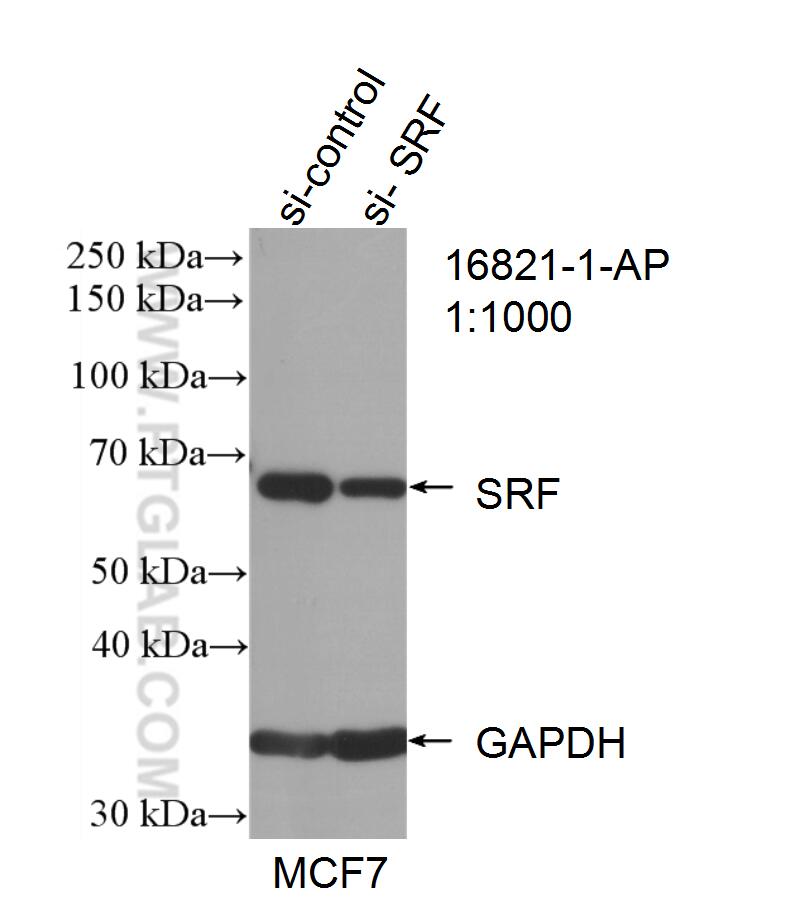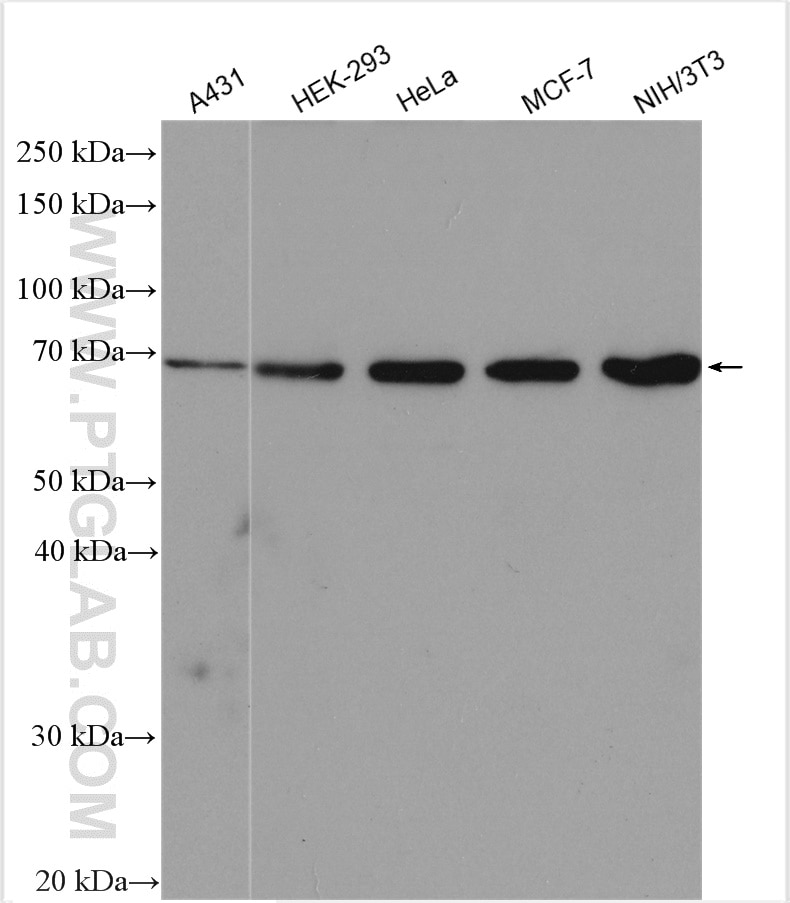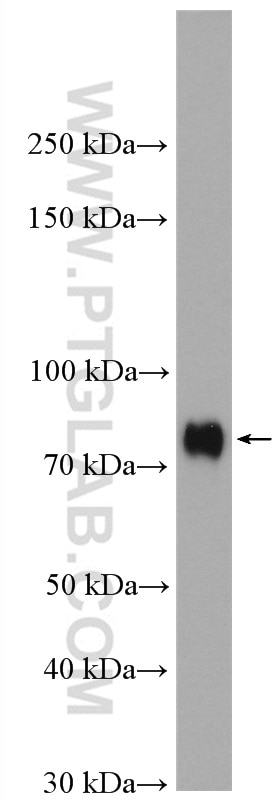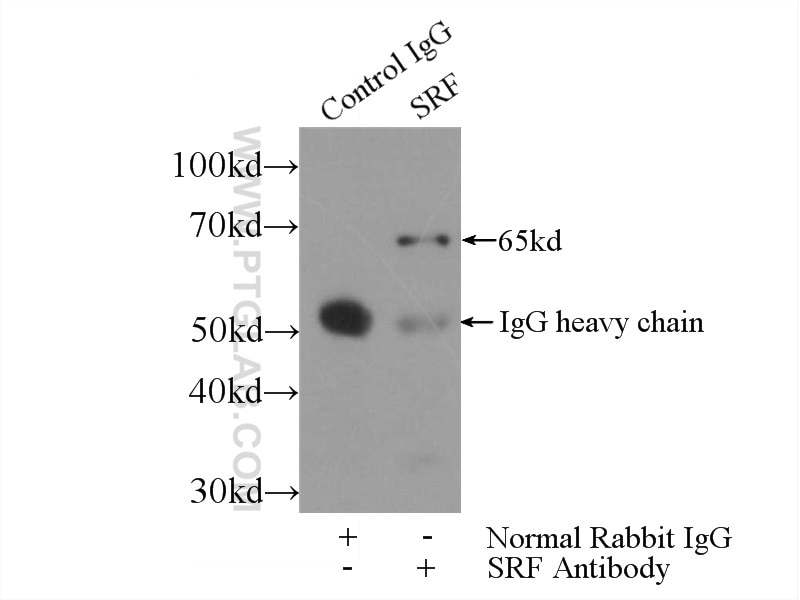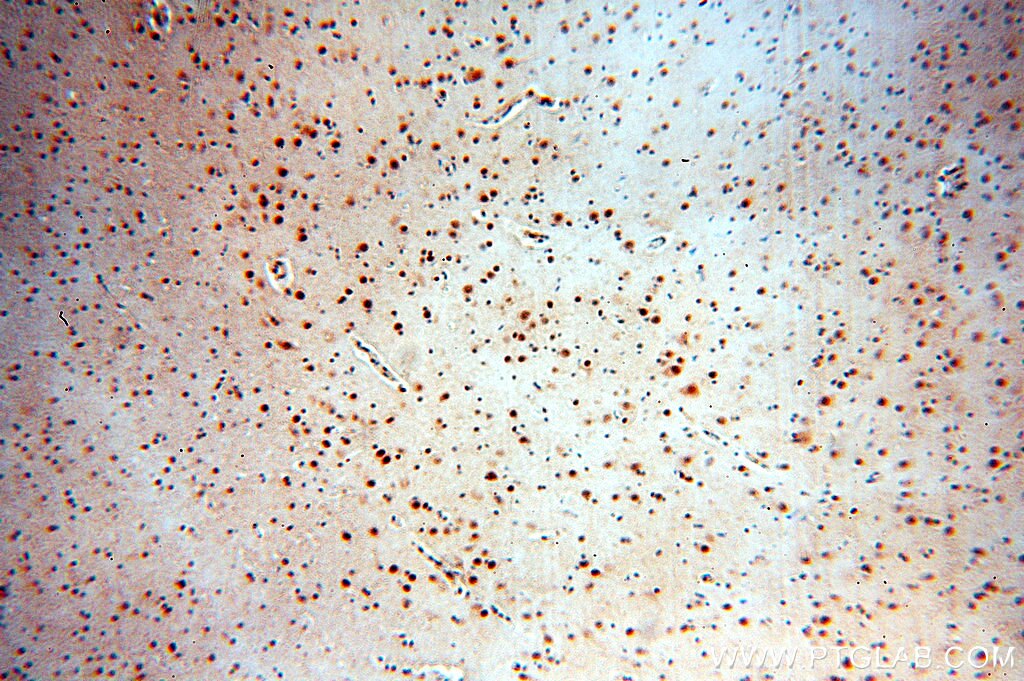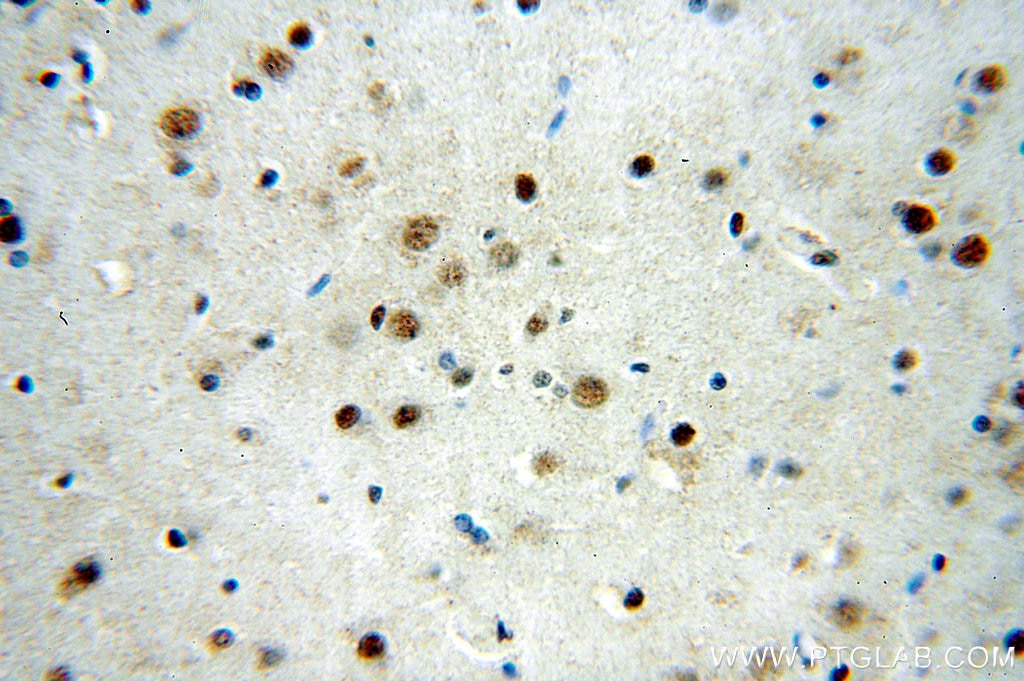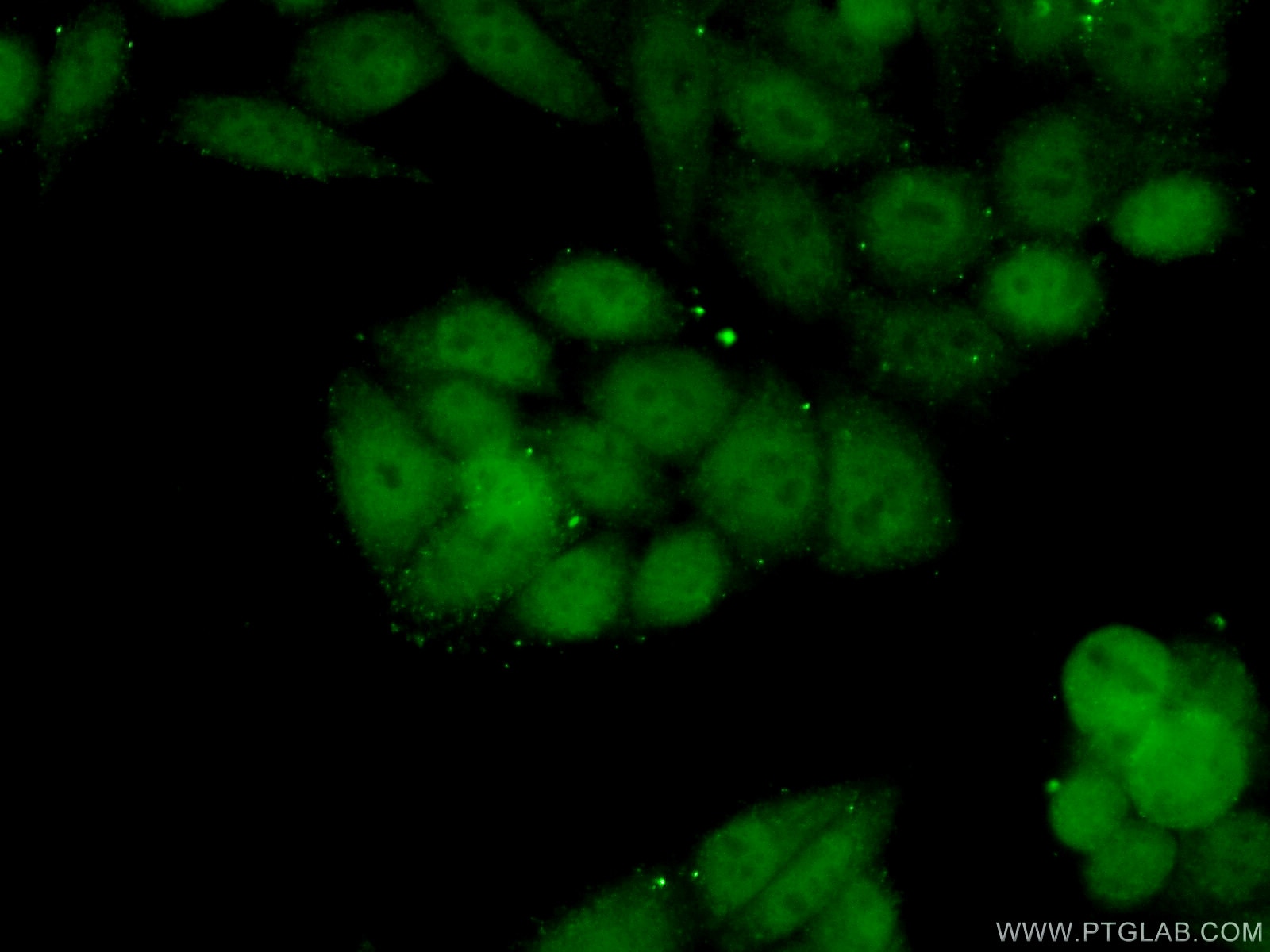- Phare
- Validé par KD/KO
Anticorps Polyclonal de lapin anti-SRF
SRF Polyclonal Antibody for WB, IP, IF, IHC, ELISA
Hôte / Isotype
Lapin / IgG
Réactivité testée
Humain, souris et plus (1)
Applications
WB, IHC, IF/ICC, IP, CoIP, ChIP, ELISA
Conjugaison
Non conjugué
N° de cat : 16821-1-AP
Synonymes
Galerie de données de validation
Applications testées
| Résultats positifs en WB | cellules A431, cellules HEK-293, cellules HeLa, cellules K-562, cellules MCF-7, cellules NIH/3T3 |
| Résultats positifs en IP | cellules HeLa |
| Résultats positifs en IHC | tissu cérébral humain il est suggéré de démasquer l'antigène avec un tampon de TE buffer pH 9.0; (*) À défaut, 'le démasquage de l'antigène peut être 'effectué avec un tampon citrate pH 6,0. |
| Résultats positifs en IF/ICC | cellules HeLa |
Dilution recommandée
| Application | Dilution |
|---|---|
| Western Blot (WB) | WB : 1:1000-1:6000 |
| Immunoprécipitation (IP) | IP : 0.5-4.0 ug for 1.0-3.0 mg of total protein lysate |
| Immunohistochimie (IHC) | IHC : 1:20-1:200 |
| Immunofluorescence (IF)/ICC | IF/ICC : 1:50-1:500 |
| It is recommended that this reagent should be titrated in each testing system to obtain optimal results. | |
| Sample-dependent, check data in validation data gallery | |
Applications publiées
| KD/KO | See 2 publications below |
| WB | See 15 publications below |
| IHC | See 2 publications below |
| IF | See 2 publications below |
| CoIP | See 1 publications below |
| ChIP | See 1 publications below |
Informations sur le produit
16821-1-AP cible SRF dans les applications de WB, IHC, IF/ICC, IP, CoIP, ChIP, ELISA et montre une réactivité avec des échantillons Humain, souris
| Réactivité | Humain, souris |
| Réactivité citée | rat, Humain, souris |
| Hôte / Isotype | Lapin / IgG |
| Clonalité | Polyclonal |
| Type | Anticorps |
| Immunogène | SRF Protéine recombinante Ag10386 |
| Nom complet | serum response factor (c-fos serum response element-binding transcription factor) |
| Masse moléculaire calculée | 508 aa, 52 kDa |
| Poids moléculaire observé | 65-70 kDa, 40 kDa |
| Numéro d’acquisition GenBank | BC048211 |
| Symbole du gène | SRF |
| Identification du gène (NCBI) | 6722 |
| Conjugaison | Non conjugué |
| Forme | Liquide |
| Méthode de purification | Purification par affinité contre l'antigène |
| Tampon de stockage | PBS avec azoture de sodium à 0,02 % et glycérol à 50 % pH 7,3 |
| Conditions de stockage | Stocker à -20°C. Stable pendant un an après l'expédition. L'aliquotage n'est pas nécessaire pour le stockage à -20oC Les 20ul contiennent 0,1% de BSA. |
Informations générales
Serum response factor (SRF) is a transcription factor that binds the serum response element (SRE), a sequence that mediates the transient response of many cellular genes to growth stimulation. SRF is required for cardiac differentiation and maturation due to the role in cardiac cell growth and muscle gene regulation. The full-length SRF protein is 67 kDa and molecular weight of cleaved fragment is 50 kDa and 20 kDa (PMID: 21769134).
Protocole
| Product Specific Protocols | |
|---|---|
| WB protocol for SRF antibody 16821-1-AP | Download protocol |
| IHC protocol for SRF antibody 16821-1-AP | Download protocol |
| IF protocol for SRF antibody 16821-1-AP | Download protocol |
| IP protocol for SRF antibody 16821-1-AP | Download protocol |
| Standard Protocols | |
|---|---|
| Click here to view our Standard Protocols |
Publications
| Species | Application | Title |
|---|---|---|
Exp Mol Med Helicobacter pylori CagA-mediated ether lipid biosynthesis promotes ferroptosis susceptibility in gastric cancer
| ||
Cell Physiol Biochem Galectin-3- Mediated Transdifferentiation of Pulmonary Artery Endothelial Cells Contributes to Hypoxic Pulmonary Vascular Remodeling. | ||
Stem Cell Res Ther Activin B-activated Cdc42 signaling plays a key role in regulating adipose-derived mesenchymal stem cells-mediated skin wound healing. | ||
Am J Physiol Lung Cell Mol Physiol Myocardin regulates fibronectin expression and secretion from human pleural mesothelial cells | ||
J Immunol TPL-2 Inhibits IFN-β Expression via an ERK1/2-TCF-FOS Axis in TLR4-Stimulated Macrophages. | ||
J Am Heart Assoc Targeting AGGF1 (angiogenic factor with G patch and FHA domains 1) for Blocking Neointimal Formation After Vascular Injury. |
